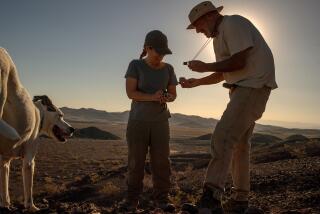Untapped Gems Could Enrich Afghans, Geologist Says
- Share via
With its casual show-and-tell presentations of lepidolite and dendritic opal and its pie-and-cookie refreshment break, the monthly meeting of the Culver City Rock and Mineral Club is the last place you’d expect to be caught up in a world crisis.
But there the stony-faced club members were this week--talking of bombing raids and land mines and human suffering in Afghanistan. And as Taliban forces were fleeing Kabul, Westside rock hounds were learning that the dirt-poor country could become a rich one.
Geologist and anthropologist Bonita Chamberlin has spent 25 years exploring Afghanistan. She told club members she is convinced that vast deposits of uranium and beryllium, oil and natural gas, gold and silver, lead, zinc and dazzling gemstones could bring unheard-of wealth to Afghans.
Over the years, Chamberlin has disguised herself as a man and slipped past Soviet army guard posts or crossed mountain ranges with arms-smuggling moujahedeen to get into Afghanistan. On her most recent trip last year, she stayed in the northern part of the country and avoided Taliban forces.
Five weeks ago, after terrorist leader Osama bin Laden appeared on a videotape made at an Afghan cave, the U.S. Department of Defense asked Chamberlin to identify the rocky outcropping in the background in hopes of pinpointing his location. Chamberlin recognized the regions where those sandstone and limestone formations are common.
“But I never know what they do with information like that. They never give me a report back,” she said.
Chamberlin, 55, of La Mesa, Calif., is a researcher and consultant who was introduced to Afghanistan in the mid-1970s while working with companies cultivating cotton and raisins there. The scope of her work changed during the Soviet invasion--when heavy bombing uncovered significant deposits of rubies, sapphires, emeralds and other gemstones, she said.
After that, Chamberlin identified 91 minerals, metals and gems at 1,407 potential mining sites. For the last eight years, she has advocated a United Nations development program that would turn Afghanistan’s deposits into a “crop substitute” for poppies grown for the drug trade. In 1995 she co-wrote the book “Gemstones of Afghanistan.”
Chamberlin, who was invited before the Sept. 11 attacks to speak to the 130-member Culver City club, managed to combine ancient Afghan history with modern horrors during her talk. But it was the geology that riveted the crowd Monday night.
“Not many people left the meeting early,” said club President Brad Smith, a Westwood silversmith.
Chamberlin explained that Afghanistan has a wealth of minerals because of the way the Earth’s plates collided when the Indian subcontinent rammed into the Asian continent, trapping chemicals from ancient seas along with chemicals from the land.
“They formed minerals that exist in very few places in the world,” she said.
Before the Sept. 11 attacks, Chamberlin said, she had been scheduled to return to Afghanistan to document the pillaging of archeological sites and the destruction of artifacts by the Taliban.
Now, she said, she would like to go there “to do some cultural diversity training so our Special Forces know how to work with tribes” that are sometimes rivals.
In the meantime, Chamberlin will speak to the Opal Society at 7:30 p.m. today at 9501 Chapman Ave., Garden Grove. And she is anxiously waiting to see how the Afghans survive the winter.
She said authorities need to dig in and take care of 5 1/2 million starving people before they start thinking about mining.
But once an infrastructure is developed, she added, Afghans “could rule the world.”
More to Read
Sign up for Essential California
The most important California stories and recommendations in your inbox every morning.
You may occasionally receive promotional content from the Los Angeles Times.










